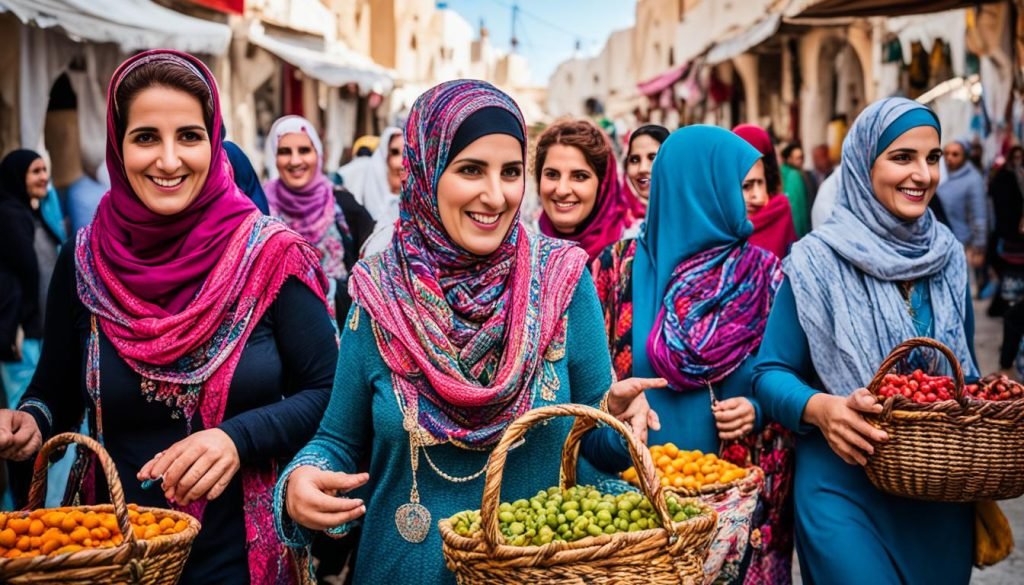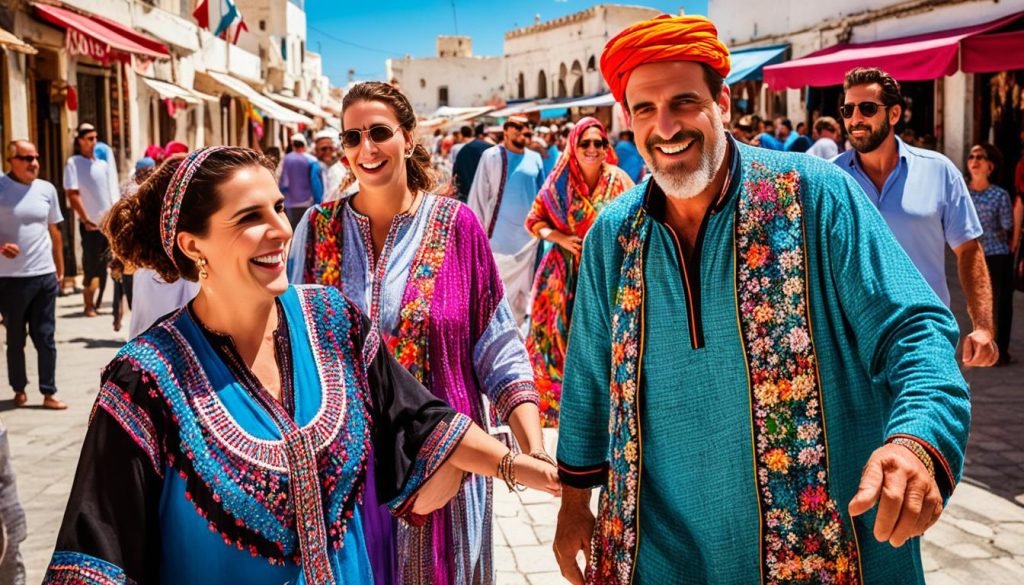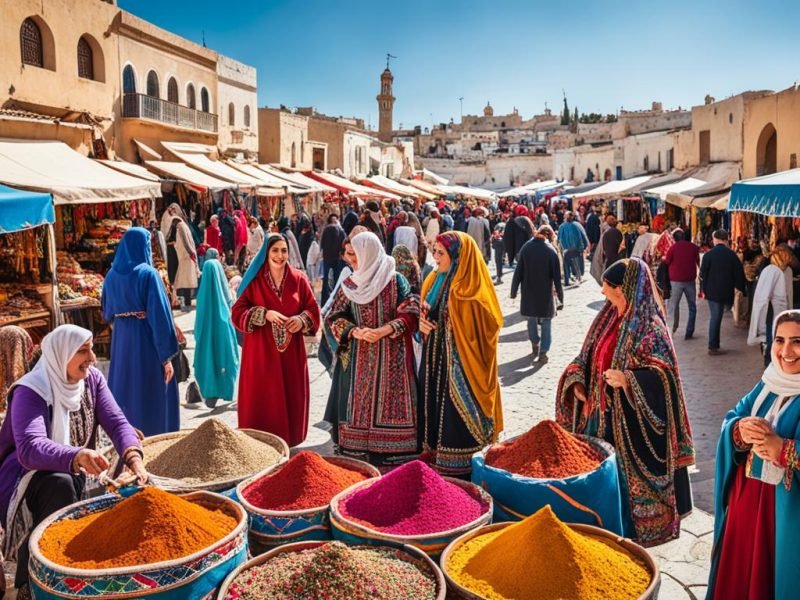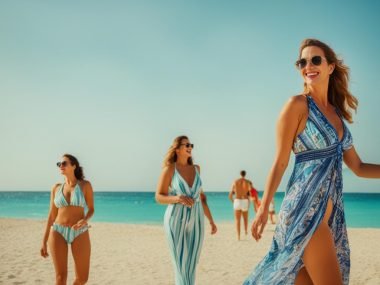In Tunisia, dressing up isn’t just about looking good. It shows respect for others. Their clothes reflect their cultural values of honor and shame. So, knowing what to wear is key for anyone who wants to really understand Tunisia, beyond just tourist spots.
In the south and small villages, dressing right means a lot. You should look modest but still stylish. This helps you blend in and avoid problems like pickpockets or too much sun. Finding a middle ground between traditional clothes and fashion makes your trip better.
Women can wear jeans, long skirts, and t-shirts, but should avoid low necklines. Men look best in jeans and short-sleeve shirts. Don’t forget strong shoes or sandals for walking. And, sunglasses are a must in the Tunisian sun.
Let’s dive into Tunisian fashion together. This way, we can avoid mistakes and enjoy our travels more, wearing the right outfits.
Key Takeaways
- Appreciate the influence of cultural values on the Tunisian dress code.
- Identify appropriate attire for various settings within Tunisia to enhance cultural respect.
- Discover the reasons behind modest dressing in conservative Tunisian regions.
- Understand the balance between traditional Tunisian garments and modern fashion sensibilities.
- Learn the importance of practical footwear and accessories suitable for Tunisia’s climate.
Understanding Tunisian Dress Code and Culture
In my time in Tunisia, a country known for its mix of old and new, I’ve seen a special thing. Tunisian clothing customs show where the country stands in the world. Tunisia is mostly Muslim, but it’s open to new social ideas. This mix is seen in how people dress. Some wear traditional clothes, and some choose Western styles. These choices depend on the weather and the culture.
When I visited rural and traditional places, I noticed people dressed modestly and with respect. Dressing this way helps you fit into local communities. It’s important to dress properly, especially in holy places. Here, women might need to wear a headscarf as part of their Tunisian traditional clothing.
Tunisia’s warm weather also affects how people dress. I’ll share some tips to dress well while respecting local customs:
- Pick clothes made of light materials to stay cool and modest.
- In cities, jeans and t-shirts are okay, but don’t wear clothes that are too casual or showy.
- Always have a scarf or shawl to cover up if needed.
Table: Comparison of Clothing Choices in Urban vs. Rural Areas
| Location | Preferred Attire | Notes |
|---|---|---|
| Urban Areas (e.g., Tunis, Sfax) | Jeans, t-shirts, light dresses | More casual, open to Western fashions |
| Rural Areas (e.g., Kairouan, Gafsa) | Long skirts, tunics, headscarves | More traditional, modest clothes |
To wrap up, Tunisian clothing customs invite us to dress stylishly but with care. By following dressing etiquette in Tunisia, we show respect and get a better cultural experience.
Clothing Choices for Women in Diverse Tunisian Settings
Choosing the right clothes for a trip to Tunisia is crucial. Understanding the local Tunisian fashion style helps. It makes your trip better.
Casual Wear: Jeans and Modest Tops
For everyday adventures, like market visits or city walks, jeans and modest tops are great. This choice respects local customs. It also matches How Do People Dress In Tunisia?. You’ll look respectful and stylish.
Tunics and Long Skirts: Embracing Local Fashion
In smaller cities or southern Tunisia, tunics with embroidery or patterns are loved. Wearing them with long skirts shows respect. It also keeps you in touch with Tunisian fashion style.
Swimwear Etiquette: Beachwear in Tourist vs Local Areas
When heading to the beach, know where you’re going. Tourist spots are okay with bikinis and a cover-up. But choose modest swimwear in local or traditional areas. This shows respect for Traditional Tunisian garments.
Wearing these styles keeps you comfortable and connects you with locals. It’s more than fashion. It’s about cultural respect and immersion.

What Men Should Wear When Visiting Tunisia
In Tunisia, dressing with respect and style is important for men. You should choose clothes that are both stylish and comfy. This means picking outfits that fit well into Tunisia’s lively culture.
Men should aim to look neat and sharp. This comes from the Tunisian way of valuing cleanliness in dress. Jeans, slacks, and knee-length shorts are good choices. They work well for both city walks and relaxing in a café.
Integration of contemporary and traditional elements in men’s fashion underscores Tunisia’s unique blend of Mediterranean charm and North African heritage.
- T-shirts and polo shirts are suitable for most daytime activities.
- Button-down shirts work well for a more polished look or for evening outings.
- Non-revealing tops, with a preference for items concealing the shoulders and torso, are recommended.
Some items don’t fit well with Tunisian culture:
- Extremely short shorts
- Tank tops
- Open button-up shirts worn without an undershirt
| Garment | Acceptable in Tunisia? | Notes |
|---|---|---|
| Jeans | Yes | Versatile for most settings |
| Knee-length shorts | Yes | Ideal for warm weather |
| T-shirts | Yes | Casual and comfortable |
| Polo shirts | Yes | Slightly more formal than t-shirts |
| Button-downs | Yes | Suitable for dinners or more formal occasions |
| Short shorts | No | Frowned upon in many public places |
| Tank tops | No | Considered too revealing for men |
| Open button-up | No | Wearing without an undershirt is not advisable |
By respecting the Tunisian dress code, men can enjoy their time without issues. It’s all about balancing respect with style. This allows for a smooth experience in Tunisia.
Dressing for Tunisia’s Climate: Seasonal Variations
Knowing what to wear in Tunisia makes your visit better. You need to think about the culture and weather. The weather changes a lot here, from hot to cool. So, you need clothes that are comfy, stylish, and right for the culture.
Summer Attire: Light Fabrics and Protection from the Sun
Summers in Tunisia are really hot. It’s important to wear clothes that keep you cool and protect you from the sun. You should wear light materials like cotton or linen. They are perfect for dealing with the heat. Long-sleeve shirts help block the sun but still feel cool.
Carrying sunscreen with high SPF is also a must. This keeps your skin safe from the strong sun. Dressing right means staying cool and protected from the sun.
Winter Outfits: Layering for Mild Cold Weather
Winters are not too cold but you can still feel chilly, especially at night. I like to wear layers. I start with a comfy base, like a t-shirt. Then, I add a fleece for warmth and a waterproof jacket for rain. Layers help you adjust to changing temperatures all day.

In both summer and winter, I make sure my clothes fit Tunisia’s weather and culture. Dressing this way shows respect for the culture. Plus, it lets me comfortably see Tunisia’s different and lovely places.
Footwear and Accessories: Completing Your Tunisian Look
Getting ready for a trip to Tunisia means knowing Tunisian clothing customs. It’s also about knowing what to wear. The right shoes and accessories are important. They help you enjoy your time in places like Tunis and the Sahel.
Choosing Practical Footwear for Exploration
When in Tunisia, it’s smart to pick shoes that are comfy and useful. Tunisia’s lands and weather change a lot. You need shoes that work in cities and in the wild. In cool weather, pick walking shoes that cover your toes. For hot summers, sandals are best. They fit dressing etiquette in Tunisia too.
Accessorizing with Purpose: Hats, Bags, and Sunglasses
The strong sun in Tunisia means you need sunglasses, hats, and scarves. Sunglasses protect your eyes. A wide hat keeps your face and neck safe from the sun. A light scarf can be a cool accessory or a head wrap. It helps against the sun too.
For safety, use a small bag that goes across your body. This way, your hands are free. A big tote bag is good for day trips. You can bring water, sunscreen, and a camera.
| Accessory | Function | Style Integration |
|---|---|---|
| Sunglasses | Sun protection | Enhance both casual and dressy outfits |
| Scarves | Versatility: from style to sun protection | Easily integrates with traditional Tunisian garments and modern attire |
| Broad-brimmed Hats | Protection from sun overexposure | Functional and fashionable, suitable for both genders |
| Cross-body Bag | Security and convenience | Blends with most styles while ensuring valuables are close |
| Tote Bag | Carries extra supplies for day trips | Practical yet stylish, reflecting smart travel fashion |
Wearing traditional Tunisian garments or choosing local styles matters. Good shoes and accessories are key. They give comfort, respect local customs, and make your trip better.
Conclusion
To dress well in Tunisia, we must know the culture and care for our comfort. Tunisian fashion style is about more than looking good. It shows respect for their vibrant traditions. By following these cultural hints, travelers connect better with locals while enjoying Tunisia’s beauty.
Getting to know How Do People Dress In Tunisia? makes trips better. It’s not just choosing clothes. It’s a way to deeply understand Tunisia. Dressing modestly, for the weather and events, shows respect. It also makes your journey smoother.
Let’s keep these tips in mind when visiting Tunisia. Understanding Tunisian dress code is key. It helps you move confidently around the country. You show respect for local ways. And maybe, dressing thoughtfully will lead to unique experiences in Tunisia’s charming places.







